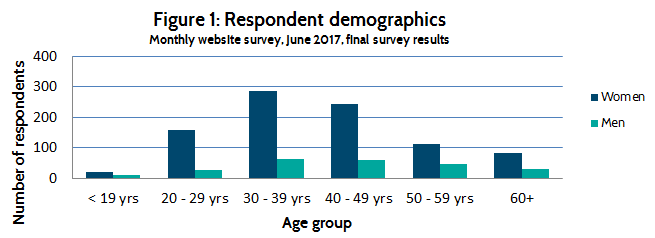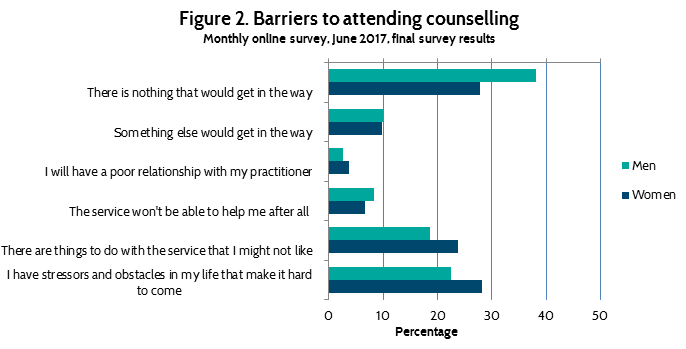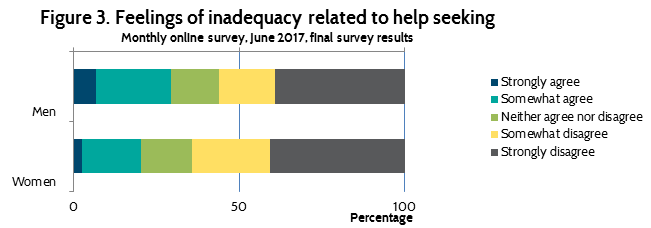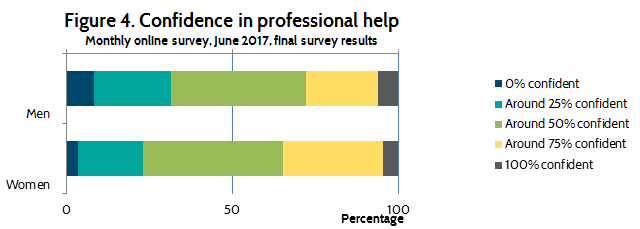Introduction
Relationships Australia has a keen interest in improving people’s access to, and experience of, services. In previous online surveys we have explored how people accessing Relationships Australia’s website undertake research to find a counsellor, their experience of counselling, and counselling engagement.
The research literature has identified individual and structural barriers that can also impact on an individual’s use of services. Studies consistently find, for example, consultation rates and help-seeking patterns in men to be at much lower levels than for women, especially where the person is experiencing emotional problems and/or depressive symptoms. Barriers identified in health studies include difficulty making an appointment and worry about wasting the professional’s time.
Other studies have looked at age-related barriers to help-seeking. In a meta-analysis of young people’s barriers to service use, perceived stigma and embarrassment, problems recognising symptoms (poor mental health literacy), and a preference for self-reliance were found to be the most important barriers to help-seeking. Lower socio-economic groups have been found to be more likely to report ‘emotional’ barriers and higher socio-economic groups are more likely to report ‘practical’ barriers, while help-seeking can also be compounded by limited availability of inclusive services that can provide culturally sensitive interventions, services and interpreters.
In June 2017, we sought to understand whether people are experiencing barriers when they are accessing Relationships Australia’s services. This month’s survey also included a link to a voluntary survey that explores barriers to help seeking in greater detail.
Previous research finds that…
- On average, couples wait about six years before getting help; however, the majority (71%) of people who have seen a counsellor report that it was a worthwhile experience for them
- Reluctance to seek treatment places stress on families and support people who can experience financial hardship, their own emotional and physical health problems, and risks to personal safety and family conflict
- Barriers to service usage can include location, lack of transport, perception of the service as irrelevant, inappropriate or stigmatising, and a lack of quality, long-term and/or specialist staff
Results
More than 1220 people responded to the Relationships Australia online survey in June 2017, with just under four-fifths of survey respondents (79%) identifying as female.
As was the case for last month’s survey, more females than males responded in every age group (figure 1). Almost ninety per cent (87%) of survey respondents were aged between 20‑59 years, with the highest number of responses collected for women aged between 30-39 years (inclusive).

The demographic profile of survey respondents remains consistent with our experience of the people that would be accessing the Relationships Australia website.
Overall, around 85 per cent of survey respondents reported that they currently had a problem they were thinking of seeking help with. More than 60 per cent of women (62%) and 50 per cent of men (52%) reported that they were currently thinking of seeking help for a family and/or relationship problem, while fewer than one-sixth (14%) of men and one-tenth of women (10%) reported they were currently thinking of seeking help for a mental health problem.
Of those survey respondents who reported a current problem, 66 per cent of men and 57 per cent of women reported their current problem was major or severe. A further 35 per cent of women and 25 per cent of men reported their current problem was moderate.
A significant number of male (38%) and female (28%) survey respondents reported if they were considering counselling there was nothing that would get in the way of them coming to a session (figure 2). Women were more likely than men to report that they had stressors and obstacles in their life that made it difficult to come to a session (women-28% compared with men-22%), or there may be things about the service they may not like such as cost or duration of sessions (women-24% compared with men-19%).

Men (30%) were significantly more likely than women (22%) to strongly agree or agree that they would feel inadequate if they sought professional help from a practitioner (figure 3).

Overall, women were more likely than men to be confident a professional service could help them overcome their difficulties. Both men (41%) and women (42%) were most likely to report confidence levels of around 50 per cent.

Of those survey respondents who reported they had a current problem, the substantial majority were considering seeking help because they would like to make changes to their current situation (men – 52% compared with women – 58%), or so they feel they can take responsibility for making changes in their lives (men – 29% compared with women – 26%).
